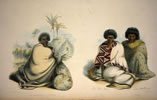Economic importance of land
The importance of land to Māori was summed up in the proverb: ‘Te toto o te tangata he kai. Te oranga o te tangata he whenua.’ (The lifeblood of a person is derived from food; the livelihood of a people depends on land.)
The loss of land meant the loss of a key economic resource for Māori. Land purchases were first entered into with the idea that Māori would benefit from Pākehā settling nearby. Māori were eager to have access to markets, and new goods and technologies that Europeans would bring.
Much of the success that Māori had in supplying early settlers and the towns they set up was based on Māori control of significant areas of land, which was communally managed to produce food. But land transfer usually gave settlers the best arable lands closest to towns and cities. The 19th century became a period of massive transfer of land from Māori ownership to government and Pākehā ownership. This had a severe impact on Māori tribal structures, and on tribal economies.
South Island
By the 1860s ownership of almost the entire South Island had been transferred from Māori to the government or European settlers. Between 1844 and 1863 the Crown bought millions of hectares of land from Ngāi Tahu in a series of nine purchases. In the 1848 Canterbury purchase alone the Crown purchased nearly 10 million hectares.
By the late 1890s the government had begun to investigate the amount of land available to Ngāi Tahu and found that only 10% of the tribe had sufficient land to provide a living. A number of landless Māori throughout the South Island were given some land. Ngāi Tahu and other South Island tribes had not had an opportunity to benefit from European settlement.
Land confiscation
By the 1860s Māori were beginning to see the effects of land loss. In the Wairarapa, Wellington and Manawatū, for example, many tribes had sold most of their land. As tribes sought to strengthen their hold on land, the government sought to acquire more land. Tensions around sovereignty, mana and land led to the New Zealand wars. As a result of these wars, around 1.5 million hectares of land were confiscated from tribes in Taranaki, Waikato, Tauranga and the Bay of Plenty. At the time it represented about 15% of land in Māori customary ownership. Much was returned, but not always to the original owners.
Land tenure changes
From 1865 the Native Land Court introduced a new system of land title based on individual ownership. It failed to recognise tribal ownership of land, and tribal control of economic interests was undermined.
Title to land was shared by members of tribes. Collective owners could not obtain capital to invest in land.
Much land was sold to pay for the expenses involved in the land court hearings, including court costs, accommodation during the court hearings and surveying.


